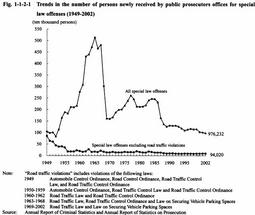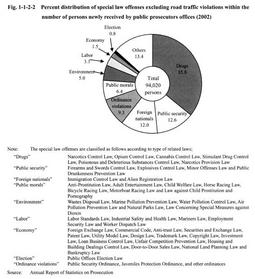| Previous Next Index Image Index Year Selection | |
|
|
1 Outline The number of persons newly received by public prosecutors offices for the 10 most common special law offenses (including violations of ordinances) in 2002 is as follows:
Principal data for 2002 (special law offenses) Cases (percent distribution) (year-on-year change) [1] Road Traffic Law violations 861.143 (88.2%) (-29.826) [2] Stimulant Drug Control Law violations 24.801 (2.5%) (-1.695) [3] Vehicle Parking Spaces Law violations 21.069 (2.2%) (-4.051) [4] Immigration Control Law violations 11.278 (1.2%) (+1.172) [5] Minor Offenses Law violations 6.513 (0.7%) (-838) [6] Poisonous and Deleterious Substances Control Law violations 5,521 (0.6%) (-475) [7] Firearms and Swords Control Law violations 4.947 (0.5%) (+229) [8] Wastes Disposal Law violations 4,341 (0.4%) (+530) [9] Road Trucking Vehicle Law violations 3,442 (0.4%) (-470) [10] Adult Entertainment Law violations 2,469 (0.3%) (+312) Others 30,708 (3.1%) Total 976,232 (100.0%) (-33,618) (Source: Annual Report of Statistics on Prosecution) By type of offense, the number of persons newly received for Road Traffic Law violations and Vehicle Parking Spaces Law violations (collectively referred to as "road traffic violations" in this white paper; see NOTES) accounted for 90.4% of the total number of persons newly received by public prosecutors offices for special law offenses and for 40.3% of the total number for all kinds of offenses including penal code offenses. Road Traffic Law violations do not include violations for which a non-penal fine is already paid subject to the traffic violation notification system. Fig. 1-1-2-1 shows the trends since 1949 in the numbers of persons newly received by public prosecutors offices for all special law offenses and for special law offenses excluding road traffic violations. The number for all special law offenses showed a sharp fall after the a peak of more than 5.14 million in 1965. It was within the 1-1.5 million range since 1988 but fell below 1 million in 2002. The number for special law offenses excluding road traffic violations has fluctuated within the 80,000-100,000 range since 1992. Fig. 1-1-2-1 Trends in the number of persons newly received by public prosecutors offices for special law offenses (1949-2002) Fig. 1-1-2-2 shows the percent distribution of persons newly received by public prosecutors offices for special law offenses other than road traffic violations categorized as special law offenses related to drugs, public security, foreign nationals, public morals, environment, labor, economy, election, and others, and ordinance violations.Fig. 1-1-2-2 Percent distribution of special law offenses excluding road traffic violations within the number of persons newly received by public prosecutors offices (2002) |

